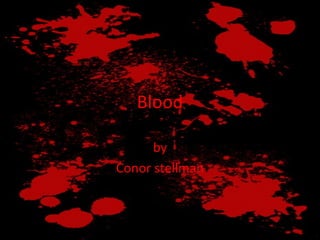Blood
•Transferir como PPT, PDF•
1 gostou•311 visualizações
Denunciar
Compartilhar
Denunciar
Compartilhar

Recomendados
Recomendados
Mais conteúdo relacionado
Mais procurados
Mais procurados (12)
Destaque
Destaque (15)
Minne menet Suomi-some? - Dingle #ContentDay 22.11.2013

Minne menet Suomi-some? - Dingle #ContentDay 22.11.2013
IAB Finland - Sosiaalisen median työryhmä: Tuloksia mittauksen suositusten lu...

IAB Finland - Sosiaalisen median työryhmä: Tuloksia mittauksen suositusten lu...
Foursquare Suomessa Q1/2013 - IAB Finland: Sosiaalisen median työryhmä 17.4.2013

Foursquare Suomessa Q1/2013 - IAB Finland: Sosiaalisen median työryhmä 17.4.2013
Tilastokatsaus: Suomen Twitter ja YouTube - Mikä on muuttunut? [SomeTime 2014...

Tilastokatsaus: Suomen Twitter ja YouTube - Mikä on muuttunut? [SomeTime 2014...
Striimaus - nyt ja tulevaisuudessa - 28.1.2013 CMAD2013

Striimaus - nyt ja tulevaisuudessa - 28.1.2013 CMAD2013
Kuinka ISO juttu YouTube on Suomessa? [TubeCON - Aikuisparkki 16.8.2014]![Kuinka ISO juttu YouTube on Suomessa? [TubeCON - Aikuisparkki 16.8.2014]](data:image/gif;base64,R0lGODlhAQABAIAAAAAAAP///yH5BAEAAAAALAAAAAABAAEAAAIBRAA7)
![Kuinka ISO juttu YouTube on Suomessa? [TubeCON - Aikuisparkki 16.8.2014]](data:image/gif;base64,R0lGODlhAQABAIAAAAAAAP///yH5BAEAAAAALAAAAAABAAEAAAIBRAA7)
Kuinka ISO juttu YouTube on Suomessa? [TubeCON - Aikuisparkki 16.8.2014]
Semelhante a Blood
Semelhante a Blood (10)
Último
Último (20)
College Call Girls Vyasarpadi Whatsapp 7001305949 Independent Escort Service

College Call Girls Vyasarpadi Whatsapp 7001305949 Independent Escort Service
Mumbai Call Girls Service 9910780858 Real Russian Girls Looking Models

Mumbai Call Girls Service 9910780858 Real Russian Girls Looking Models
Ahmedabad Call Girls CG Road 🔝9907093804 Short 1500 💋 Night 6000

Ahmedabad Call Girls CG Road 🔝9907093804 Short 1500 💋 Night 6000
Housewife Call Girls Hsr Layout - Call 7001305949 Rs-3500 with A/C Room Cash ...

Housewife Call Girls Hsr Layout - Call 7001305949 Rs-3500 with A/C Room Cash ...
Call Girls Service In Shyam Nagar Whatsapp 8445551418 Independent Escort Service

Call Girls Service In Shyam Nagar Whatsapp 8445551418 Independent Escort Service
Low Rate Call Girls Pune Esha 9907093804 Short 1500 Night 6000 Best call girl...

Low Rate Call Girls Pune Esha 9907093804 Short 1500 Night 6000 Best call girl...
Call Girls Service in Bommanahalli - 7001305949 with real photos and phone nu...

Call Girls Service in Bommanahalli - 7001305949 with real photos and phone nu...
High Profile Call Girls Jaipur Vani 8445551418 Independent Escort Service Jaipur

High Profile Call Girls Jaipur Vani 8445551418 Independent Escort Service Jaipur
Call Girls Service Nandiambakkam | 7001305949 At Low Cost Cash Payment Booking

Call Girls Service Nandiambakkam | 7001305949 At Low Cost Cash Payment Booking
Russian Call Girls Chickpet - 7001305949 Booking and charges genuine rate for...

Russian Call Girls Chickpet - 7001305949 Booking and charges genuine rate for...
Book Call Girls in Yelahanka - For 7001305949 Cheap & Best with original Photos

Book Call Girls in Yelahanka - For 7001305949 Cheap & Best with original Photos
Dwarka Sector 6 Call Girls ( 9873940964 ) Book Hot And Sexy Girls In A Few Cl...

Dwarka Sector 6 Call Girls ( 9873940964 ) Book Hot And Sexy Girls In A Few Cl...
Call Girls ITPL Just Call 7001305949 Top Class Call Girl Service Available

Call Girls ITPL Just Call 7001305949 Top Class Call Girl Service Available
Call Girls Thane Just Call 9910780858 Get High Class Call Girls Service

Call Girls Thane Just Call 9910780858 Get High Class Call Girls Service
Glomerular Filtration and determinants of glomerular filtration .pptx

Glomerular Filtration and determinants of glomerular filtration .pptx
Call Girl Lucknow Mallika 7001305949 Independent Escort Service Lucknow

Call Girl Lucknow Mallika 7001305949 Independent Escort Service Lucknow
Bangalore Call Girls Marathahalli 📞 9907093804 High Profile Service 100% Safe

Bangalore Call Girls Marathahalli 📞 9907093804 High Profile Service 100% Safe
call girls in green park DELHI 🔝 >༒9540349809 🔝 genuine Escort Service 🔝✔️✔️

call girls in green park DELHI 🔝 >༒9540349809 🔝 genuine Escort Service 🔝✔️✔️
Call Girl Koramangala | 7001305949 At Low Cost Cash Payment Booking

Call Girl Koramangala | 7001305949 At Low Cost Cash Payment Booking
Blood
- 1. Blood by Conor stellman
- 6. pictures
- 7. The End
